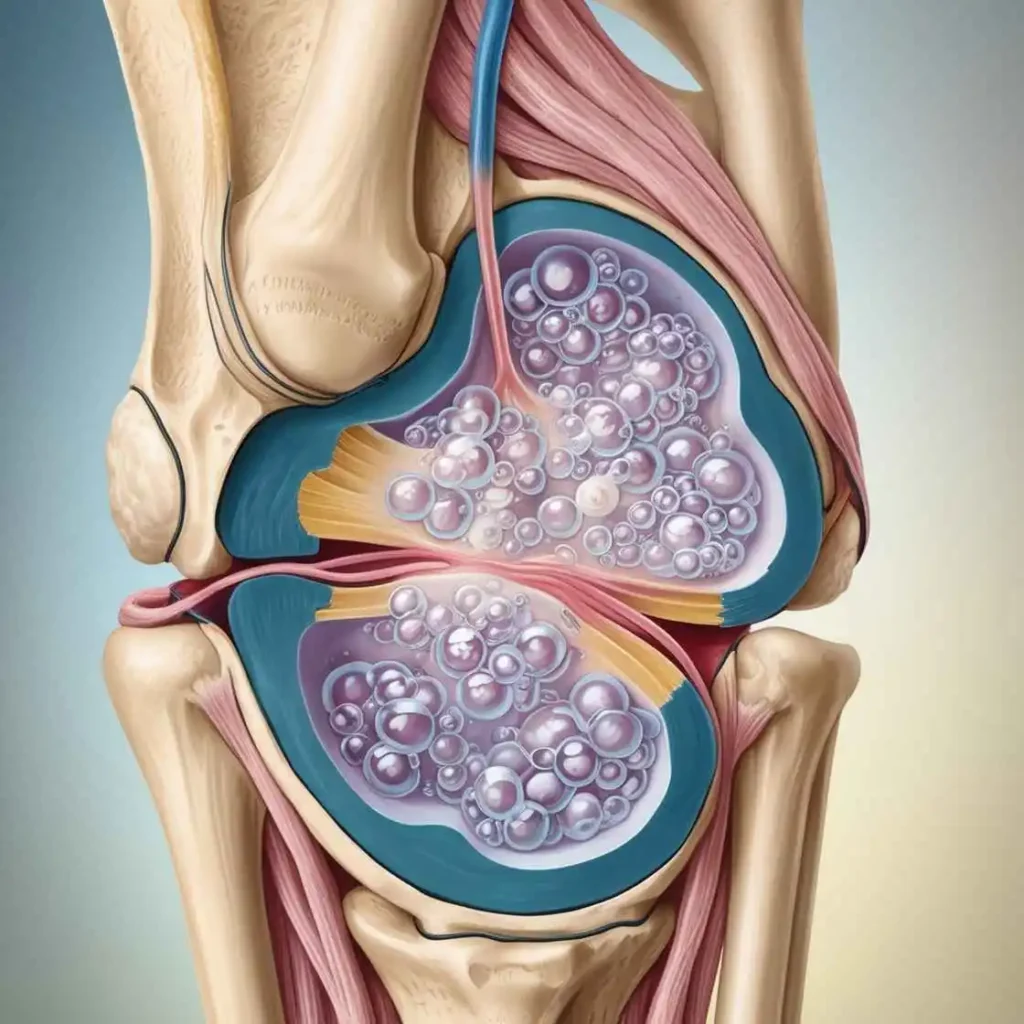Does your knee make that annoying clicking sound? If you’ve ever thought it might mean your bones are rubbing together, you’re not alone this is a common misconception. The truth is, that “clicking” sound, known as crepitus, isn’t just a concern for the elderly; it can happen to anyone.
But why does it happen, and what can you do about it? You’ve probably asked yourself, “Why does my knee click?” and you deserve a straightforward answer. We’ll go deep into the causes behind those clicks and, more importantly, explore the best treatments to keep your knees happy. While many people turn to osteopathic therapy, is that truly the only option? In this article, we’ll dig into all your options to find the most effective and affordable solutions for your clicking knees.
Understanding The Clicking knee Joint
Hearing your knee clicking as you bend, walk, or climb can be frustrating as well as a warning sign that you have a problem that needs attention.
Inside, the knee is made up of three bones: the femur (thigh bone), tibia (shin bone), and patella (kneecap). These bones fit together and are covered in slippery hyaline cartilage, allowing smooth movement. A fluid-filled sac called the synovial membrane lubricates the joint, reducing friction. Supporting these are cartilage, ligaments, muscles, and nerves, all working together to keep your knee functioning smoothly.
Knees are powerhouse joints, designed to bear significant weight and handle the stresses of daily activities. Almost any movement that uses your legs relies on your knees. While it’s true and okay that many of our joints can make popping sounds at times and knees are no different. What’s not okay is experiencing pain or swelling in your knee and letting it go. It’s important to distinguish between harmless clicks and those that signal trouble.

Common causes of knee clicking
Gas Bubbles in the Joint
Sometimes, the noise you hear in your clicking knees is caused by tiny air bubbles in the joint fluid. These bubbles form when the pressure in the joint changes, and when they pop, it’s called cavitation. This is usually nothing to worry about, as long as there are no other symptoms like swelling or severe pain.
Ligament or Tendon Movement
Another possible cause of clicking knee joints is when the ligaments and tendons catch as they go over a bony lump and pop as they snap back into place. Like cavitation, this is also not considered a serious problem unless other symptoms occur.
Meniscus Issues
The meniscus is a cartilage cushion in the knee. As it gets torn or damaged, it can cause a clicking sound along with pain, swelling, or a sensation of the knee locking. This could mean a small piece of loose cartilage is caught in the knee, which needs further investigation.
Patellofemoral Pain Syndrome (Runner’s Knee)
Patellofemoral Pain Syndrome, or “runner’s knee,” occurs when the underside of the kneecap becomes rough, causing clicking or grinding sensations. This often results from misalignment of the kneecap, leading to knee clicking when walking or bending the knee, and is usually accompanied by front knee pain. This needs to be addressed promptly.
Osteoarthritis
If you’re experiencing painful and persistent popping or clicking knee joints, it could be a sign of osteoarthritis, where the smooth cartilage wears down, causing bones to rub against each other. This condition, more common in older individuals, often leads to pain, stiffness, and limited mobility.
When Should You Be Concerned?
A knee clicking when straightening leg or bending it with no pain is usually something not to worry about. But there are some signs you should definitely pay attention to:
Persistent Clicking with Pain or Swelling: When knee clicking is accompanied by swelling or severe pain, it’s a good idea to see a doctor for a check-up and a clear diagnosis.
A Pop and Swelling After an Injury: Hearing a pop and swelling up when you injure your knee might mean you’ve damaged something important, like the ACL, PCL, MCL, meniscus, or cartilage.
A feeling of Instability or Trouble Moving: When clicking in your knee is accompanied by a feeling of instability or difficulty fully straightening or bending it, you should get it checked out
Sudden Clicking After an Injury: The clicking suddenly after an injury is troublesome, it’s worth having a professional take a look to rule out any damage.
In short, while having pain, instability, or swelling with that clicking sound, it’s smart to see a physician to prevent any further problems. And even if you’re just worried but not in pain, visiting a knee specialist can give you some peace of mind.
Osteopathic Approach to Treating Knee Clicking and Pain
Do you also believe like many others “Osteopaths only treat back problems”? Well, that’s not true! Yes! Osteopaths do treat back problems. However, chronic back pain is far from the only ailment that osteopaths see daily. Various osteopaths offer treatment for a range of medical conditions, including headaches, neck and shoulder pain, arthritic pain, hip, knee and ankle pain, and other conditions like sciatica and scoliosis.
An osteopath might be just what you need with a clicking knee. They take a full-body approach, working to get everything back in balance so your knee can move smoothly again. It’s all about helping you feel better and move more comfortably.
Here’s how the Osteopathic approach works for the clicking knee:
Comprehensive Assessment
An osteopath takes a close look at how your knee moves and how it aligns with the muscles and joints around it. During this assessment, you will discuss the current pain you are experiencing, past injuries, your health history, illnesses or surgeries. They’ll also examine how you stand and walk or if there is any inflammation, swelling or biomechanical imbalance contributing to your pain to observe anything that might be adding to your knee pain
Manual Therapy
Osteopaths work their magic with gentle, hands-on techniques such as stretching and massage to help your knee move better. They focus on improving flexibility, easing muscle tension, and boosting circulation. A clicking knee or tight muscles can be dealt with with ease, they can help get everything back to normal. It’s all about ensuring your knee is moving comfortably.
Exercise Prescription
Some recommended exercises by your osteopaths will keep your knee in top shape. Strengthen your knee with squats and lunges, stretch for better flexibility, and work on balance with moves like standing on one leg. Low-impact activities, like swimming or cycling, keep your knee active without adding stress. This combo helps ease pain and boost flexibility.
Postural and Gait Training
By improving your posture, you’ll help align your body better, which takes the unnecessary strain off your knees. Gait training focuses on adjusting how you walk to make sure your weight is evenly distributed and your movements are smooth. Also, an off gait can lead to uneven wear and tear on your knees, causing pain over time.
Advice on Lifestyle and Activity Modification
Your osteopaths will recommend you opt for softer surfaces when walking, choose low-impact exercises like swimming or cycling, and make sure to take frequent breaks restraining yourself from sitting or standing for long periods. Invest in supportive footwear to cushion your steps and avoid heavy lifting to reduce pressure on your knee.
Stop being worried that osteopathy might be painful, it’s not. Osteopaths are skilled in using gentle, non-invasive techniques tailored to your specific needs. Many patients walk away feeling relief and relaxation, not pain.
Parting Words
So, what can you do about those knee clicks? First, it’s important to know that most knee click when bending or walking are harmless. They’re often caused by things like gas bubbles or ligament movement. But understanding the real reason behind your knee clicks—whether it’s something minor or a sign of arthritis lets you take the right action.
Osteopathy offers a non-invasive solution. This includes assessing your knee’s movement, using manual therapy to relieve tension, prescribing exercises to strengthen and stabilise your knee, and advising on lifestyle changes to prevent future discomfort. These steps can help you reduce pain and get back to enjoying your day without worrying about your knees.
For those looking for expert care, Dr. Phil Austin, a leading osteopath at the Osteopath Sydney, specialises in addressing knee click issues. His expertise can help you get back to moving comfortably without the persistent concern of clicking knees.
Wishing you healthier knees days ahead.


